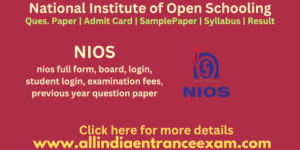NIOS, an acronym standing for the National Institute of Open Schooling, is a beacon of flexible and accessible education in India. Established in 1989, it empowers individuals of all ages and backgrounds to pursue secondary and senior secondary education through its open schooling system. Let’s delve into the key aspects of NIOS:
1. NIOS Full Form:
NIOS stands for the National Institute of Open Schooling. Established in 1989, it’s an autonomous organization under the Ministry of Education, Government of India. NIOS is dedicated to providing quality education through an open and distance learning system, making education accessible to all, regardless of location, age, or background.
2. NIOS Board:
While not technically a board in the conventional sense, NIOS operates under the Ministry of Education (MOE), Government of India. It enjoys recognition at par with other central boards like CBSE and CISCE, making its certificates widely accepted for further studies and employment.
3. NIOS Login & Student Login:
Accessing the NIOS portal is crucial for various tasks. Students can use the “Student Login” section to:
- Register for NIOS programs
- Download study materials
- Submit assignments
- Check examination results
- Access other essential services
Navigating your NIOS journey requires logging in to the appropriate portal. The NIOS Login (https://www.nios.ac.in/) is the main website where you can access information, download forms, and track your progress. As a registered student, you’ll also have a separate NIOS Student Login (https://sdmis.nios.ac.in/) to manage your enrollment, study materials, and examination schedules.
4. NIOS Examination Fees:
Examination fees at NIOS are significantly lower compared to regular schools. You can find the updated fee structure for different programs on the official NIOS website.
5. NIOS Previous Year Question Papers:
Practicing with previous year question papers is a valuable strategy for preparing for NIOS exams. The institute provides easily accessible question papers from past years on its website, helping students familiarize themselves with the exam format and question types.
6. NIOS Admission:
The admission process for NIOS is simple and convenient. You can register online on the official website throughout the year, filling out an application form and submitting relevant documents.
7. NIOS Admission Last Date:
Important to note, while registrations may remain open through the year, specific programs might have fixed admission deadlines. Always check the official NIOS website for program-specific last dates to avoid missing out.
8. NIOS Result:
Once you’ve completed your exams, you can check your NIOS Result (https://results.nios.ac.in/) online. The results are usually declared within a few months after the exams. If you’re not satisfied with your result, you can opt for re-evaluation or re-examination as per NIOS guidelines.








